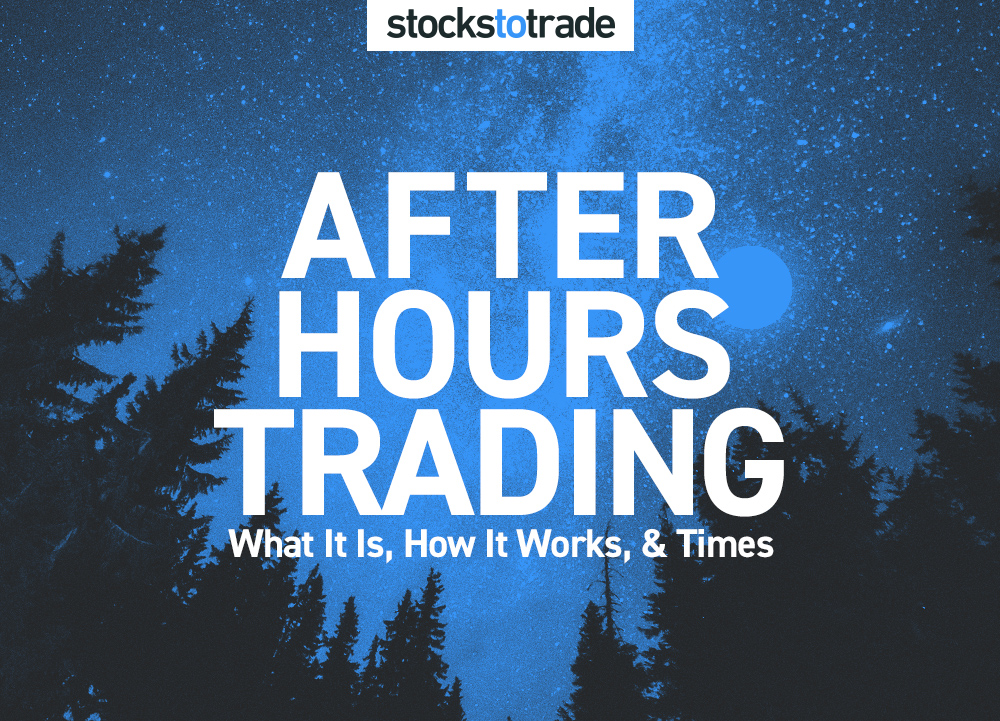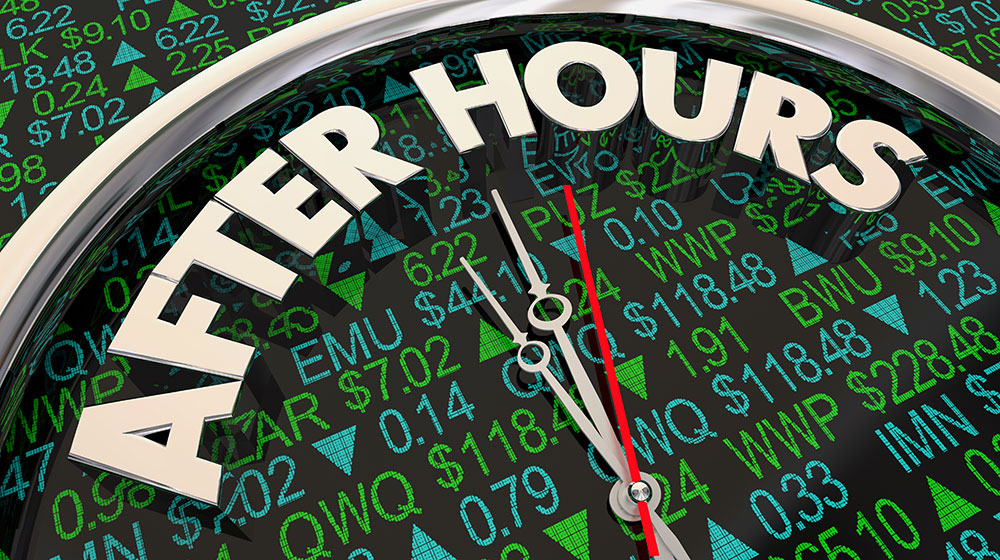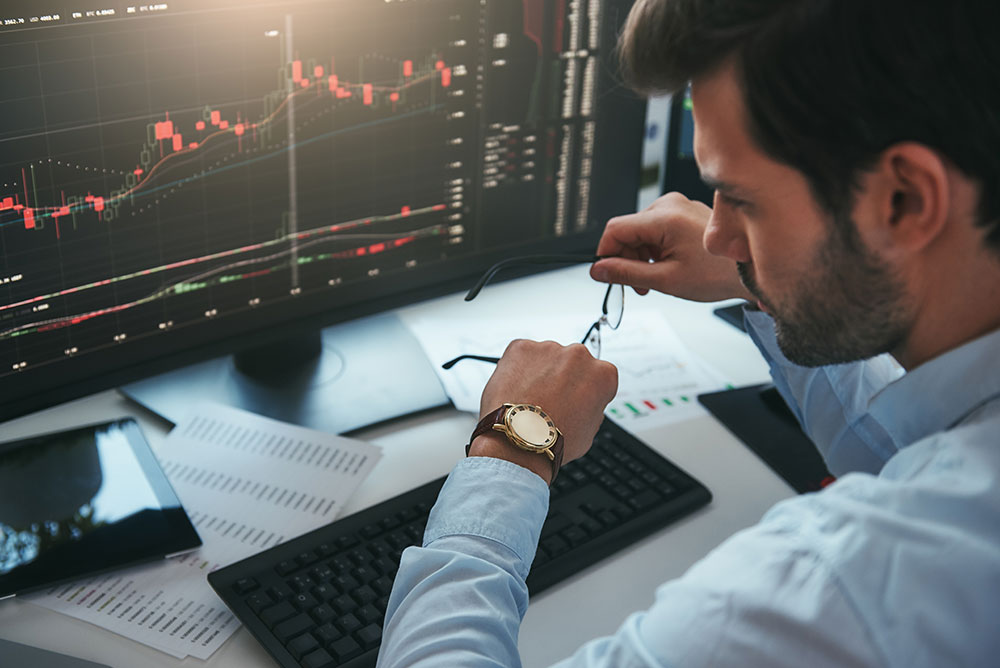If you spend any time researching stocks (as you should), you likely see some stock prices rise or fall during after-hours trading.
But what does that really mean? What is after-hours trading? How can you make trades after the markets close?
Confused by all this? You’re not alone. After-hours trading is often overlooked, especially by new traders. Not many know how to make after-hours trades, who can make these trades, or whether post-market trading is even smart.
Don’t stay in the dark. Understand exactly why after-hours trading can be risky and who stands to benefit from making post-market moves.
Ready to learn more?
Let’s take a look at what after-hours trading is, how it works, who can do it, and how you can decide if a post-market trade is a wise move.
Table of Contents
What Is After-Hours Trading?
First things first: What is after-hours trading?
Well, it’s pretty much exactly what it sounds like — trading that takes place after the stock markets close for the day.
It allows traders to buy and sell stocks after the markets close by matching buyers and sellers without using one of the major exchanges. Instead of using an exchange, traders use electronic communication networks (ECNs) to make after-hours trades.
Basically, if you want to make a play after the markets close, after-hours trading lets you do exactly that.
Also, note that after-hours trading isn’t quite the same as early morning trading. They’re essentially the same idea, but one takes place after market close and the other takes place before the market opens the next day.
You often see post-market and pre-market trading lumped together under the term extended-hours trading.
How Does After-Hours Trading Work?
For the most part, the key difference between after-hours trading and normal day trading is that after-hours trading relies on ECNs rather than stock exchanges.
Buyers and sellers use these digital exchanges to make trades without having to rely on a major exchange like Nasdaq or the NYSE.
During after-hours trading, you can generally trade stocks and ETFs as normal. But if you’re trying to trade less common financial instruments (like options), you might have a little trouble finding a buyer or seller.
Note that there can be some limitations, though. Once the markets close, demand can significantly drop. For example, if you place a buy order for a certain number of stock shares but can’t find a seller, your order might be canceled until the markets open the next day.
But for the most part, after-hours trading works just like normal trading.
After-Hours Trading Times
So when does after-hours trading start? If you want to try your hand at after-hours trading, you gotta know the details. Here are the after-hours trading times for the NYSE and Nasdaq stock exchanges…
New York Stock Exchange
The New York Stock Exchange (NYSE) opens at 9:30 a.m. and closes at 4 p.m. Eastern.
After-hours trading on the NYSE lasts from 4 p.m. until 8 p.m. Eastern.
Nasdaq Stock Exchange
For the Nasdaq Exchange, the hours are the same as the NYSE. So, standard trading hours last from 9:30 a.m. to 4 p.m. Eastern. And just like the NYSE, after-hours trading on Nasdaq lasts from 4 p.m. until 8 p.m.
While after-hours trading times can vary from market to market, it typically lasts three to four hours after standard trading times end.
Who Can Trade After Hours?
Think you’re ready to try after-hours stock trading?
Here’s the good news: after-hours trading is available to pretty much any trader. Whether you can do it mostly depends on if your broker offers it.
Most major brokers let you trade after hours from 4 p.m. to 8 p.m., but some brokers have smaller windows for post-market trading. Also, some brokerages charge additional fees for after-hours and pre-market trading. Check with your broker to get the specifics.
Also, keep in mind that some brokers have special rules for after-hours trading. For example, some brokers only allow limit orders during extended trading hours. There’s a good chance you won’t be able to place any stop orders or buy any options or bonds.
That said, if you want to give after-hours trading a shot, there’s a good chance you can do so through your broker. If not, almost any other major brokerage will let you do it. Just remember to check your broker’s policies before you try post-market trading.
Risks of After-Hours Trading
After-hours trading can have some advantages, but it comes with downsides, too. Just like any trading, there are risks you need to consider when crafting your trading strategy … and before making any moves.
Keep these risks in mind before you dive into the world of after-hours trading.
1. Trade Pricing Volatility
Volatility can be a day trader’s best friend, but it also increases your risk.
Remember that stocks can be more volatile after the stock markets close. And these price changes often don’t always carry over into the next day’s standard trading hours.
There are two main reasons volatility can increase during after-hours trading…
First, there are fewer securities traded. This generally translates into larger price fluctuations than you might see during the day.
Second, news catalysts can cause some dramatic price changes. Things like earnings reports, mergers, and other news can impact stock prices, and these reports can come while the markets are closed.
So, if you decide to try post-market trading, you can expect to see different trading prices due to the high volatility.
2. Lack of Liquidity
Another after-hours trading issue you need to consider is poor liquidity.
When you make a trade, you have to be able to find a trade partner. During after-hours trading, there just aren’t as many buyers and sellers as there are during normal trading hours.
With weak liquidity comes higher trading prices, issues with placing trades, and uncertainty around prices. This can mean more risk for day traders who want quick, time-sensitive moves.
Lack of liquidity isn’t always an issue you’ll run into during standard trading hours. But it’s a risk you definitely need to be aware of if you plan to trade during extended hours.
3. Only Limit Orders
This one isn’t so much a risk — but it is a downside to trading after hours.
A lot of brokers only allow traders to place limit orders. It’s one attempt to help protect traders from some of the risks of after-hours trading. So this can mean that if the price moves away from your limit price, your order may not be executed at all.
You’ll also need to check to see how your broker handles unfilled limit orders … Are they automatically executed the next trading day? Are they taken off the table completely?
These are important questions to ask. Be sure to do your research so that you don’t end up buying or selling a stock at a price that you didn’t plan for in your strategy.
4. Trade Order Handling
When you’re trading stocks, one of your top goals is to always get the best possible price according to your trading plan. But when you buy or sell stocks after hours, this doesn’t always happen.
To minimize this risk, contact your broker and ask about how they handle after-hours trades. You want to be confident that your broker will always work to get you the best price available.
5. Wider Trade Quote Spreads
Another big risk with post-market trading is a wider trade quote spread than normal. A spread is the difference between the bid and ask price on a stock.
Lower demand means you’re less likely to have your trade executed at the price you expect.
Just like trading during standard hours, one of the most important things you can do is consider your risks and try to minimize them as much as possible. So work to build a solid strategy to combat these risks when considering after-hours trading opportunities.
Benefits of After Hours Trading
So those are some of the downsides … but what about the upsides?
There’s more to after-hours trading beyond having extra time to make plays. Let’s take a look at why some traders participate in after-hours trading sessions.
Act on News Catalysts
News catalysts can have major impacts on stock prices. From earnings releases to company scandals, news catalysts can create countless trading opportunities.
Since news catalysts often happen while the major exchanges are closed, extended-hours trading can give traders an opportunity to react to events as soon as they happen. So next time you see breaking news or fresh information, you don’t necessarily have to wait until the next trading day. You can make a play right then and there.
Trade Around Your Schedule
Not everyone’s a full-time trader. A lot of traders have other jobs and responsibilities that can make it difficult to keep up with the stock market.
One of the biggest benefits of after-hours trading is that it allows you to make trades when you finally have some free time.
Of course, it’s not always wise to do all your trading after hours — keep those risks we just covered in mind. But extended-hours trading can give you some extra time to execute your strategies. This can also be a benefit for traders around the world who struggle to get trades in during the standard market hours.
Volatility
Most traders have a bit of a love/hate relationship with volatility. So how can volatility be a benefit and a risk?
While volatility definitely makes things riskier, it can also mean you might find appealing prices amid dramatic price changes.
Smart day traders learn how to can use volatility to their advantage. Learn to practice proper risk management … and how you can use volatility to your favor.
Bottom line: after-hours trading can an interesting avenue for traders to explore. But always remember the risks and study thoroughly before you jump in. The benefits may seem attractive benefits — but don’t be blind to risks that can come with evening trading sessions.
StocksToTrade Pro
No matter what time you trade — standard hours, after hours, or pre-market — you need to prepare for every single trade. It’s incredibly important to go into the market with a well-researched and thoughtfully developed strategy.
That’s why we designed StocksToTrade Pro. Our goal is to help demystify the market and show you how to master the skills of a pro trader.
When you join the StocksToTrade Pro program, you’ll receive guidance from Tim Bohen — StocksToTrade’s lead trainer.
Whether you’re a total beginner or you’re working to hone your market skills, Tim’s coaching, guidance, and mentorship can help you learn what it takes to be a pro.
Trading is far from easy. But by joining this program and committing yourself to learning the tricks of the trade, you can find a community and network of support.
Ready to get started? Sign up for StocksToTrade Pro today!
Final Thoughts
After-hours trading can be mystifying for a lot of traders. You’ve probably heard of it, but maybe you have no idea how to do it, whether you can do it, and if it’s even worth your time.
Here’s the thing … The reality is that after-hours trading is just like anything related to the markets and trading. Sure, it can come benefits and opportunities, but it comes with plenty of risks, too.
If you think this is a strategy you want to try, build your knowledge base first. Work with an experienced mentor who can explain the ins and outs. And if you do jump in after hours, make sure you have a detailed trading strategy and stick to your plan.
What do you think about after-hours trading? Does it seem worth it? Let us know in the comments below!






